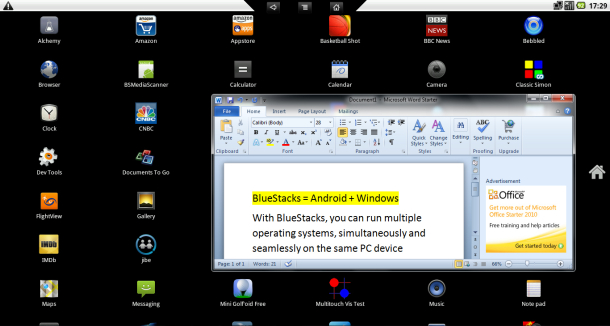Via cnet
-----
If you miss your
Android apps when using your PC, a start-up called BlueStacks says it has the answer.
Today, the company announced first-round funding of $7.6 million from
Ignition Ventures, Radar Partners, Helion Ventures, Redpoint Ventures,
and Andreessen Horowitz for its virtualization technology that provides a
foundation for Google's mobile operating system atop Windows. It's got
partnerships with Citrix for distribution to interested businesses and
with assorted as-yet unnamed PC makers for consumers.
"The idea is very simple," said Chief Executive and co-founder Rosen
Sharma, who previously was McAfee's chief technology officer. It started
when the 6-year-old daughter of another company co-founder was using
Android apps on his smartphone. "She went to a Netbook, and she wanted
the same apps on it," Sharma said. But it wasn't possible at the time.
"The number of people who want something like that is very, very large--both consumer and enterprise," Sharma said.
Consumers could be interested in having a Windows version of their
LinkedIn app for social and work connections, their sports app for
staying on top of the latest game results, or Pulse app for reading
news, Sharma said. And businesses are interested in extending the reach
of mobile apps they've created for their employees.
"A lot of people are doing their own apps" inside the company, Sharma
said. "The GM dealership app is an Android app. People who were doing
BlackBerry apps earlier are doing Android apps now."
The company, incorporated in 2008, plans to release a free beta version
of its software for people to download in June or July. It hasn't yet
set pricing for the final version, which is due to ship in the fourth
quarter. Partnerships with PC makers should be announced starting next
week, the company said.
Once people install the software, running an Android app is easy, Sharma
said. "From the user experience, it looks just like they're using an
app," he said.
Indeed, my CNET colleague Seth Rosenblatt found using Android apps on Windows with BlueStacks a seamless and effortless process.
BlueStacks uses Amazon.com's Android marketplace to distribute apps
because Google restricts its Android Market to specific ARM-based
devices.
User interface issues are one complication. Smartphone apps are designed
for a touch-screen interface and sometimes for a multitouch interface,
so some things won't work easily with a mouse and keyboard. Sharma
brushed the worry aside, though.
"We are seeing a lot of touch devices. In two years, a standard laptop
will have a touch screen," he said. In addition, trackpads on new
laptops support multitouch gestures such as pinching and zooming, he
said.
"That leaves very few apps that require absolute touch or multitouch,
like games," Sharma said. "The coverage you get is pretty large."
There are some caveats. Android today runs on the variety of ARM processors that are used in smartphones and
tablets,
but Windows machines--for now at least--use x86 chips from Intel or
Advanced Micro Devices. BlueStacks therefore runs its own build of the
OS from the open-source Android project.

The kind of high-powered apps you could run in Android include Microsoft Word and Adobe Photoshop.
(Credit:
BlueStacks)
Another processor complication is that some Android programs--the
Firefox
and Opera browsers, for example--use the Native Developer Kit that
Google provides for software makers that want to write software that
runs directly on the processor rather than on Android's Java-like
software foundation. Those won't run on BlueStacks today.
But they will later.
"Most apps are cross-platform. But any app that uses native ARM code
will not run today," Sharma said. "We will enable those apps by
December."
Ultimately, BlueStacks expects to bridge the gap the other way, too,
letting Windows apps run on Android. That will work only on x86 versions
of Android, which currently aren't on the market.
Campbell, Calif.-based BlueStacks has only 20 employees now, and most
are in India where expenses are lower, so payroll costs won't drain the
bank account quickly. Instead, the company plans to use its VC money to
try to spread its software foundation as rapidly as possible.
"Our question is getting distribution," Sharma said. He expects to have
20 million copies distributed through computer makers and 60 million
through Citrix's software channel, he said.
"Our goal is by end of 2012 to have a ridiculous-looking distribution number. Then the game changes completely," Sharma said.
-----
Bluestacks

